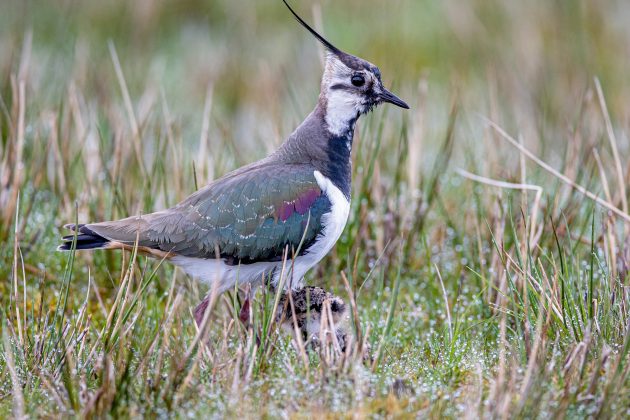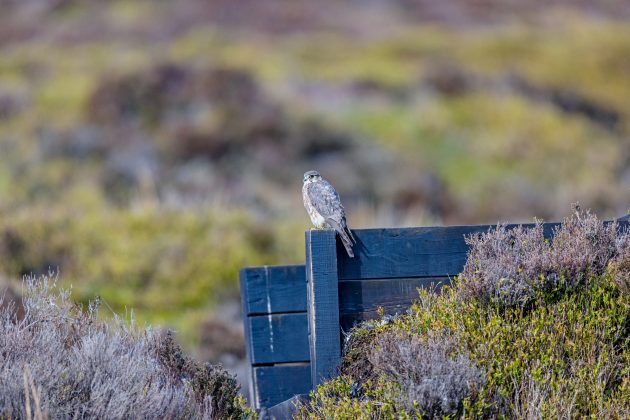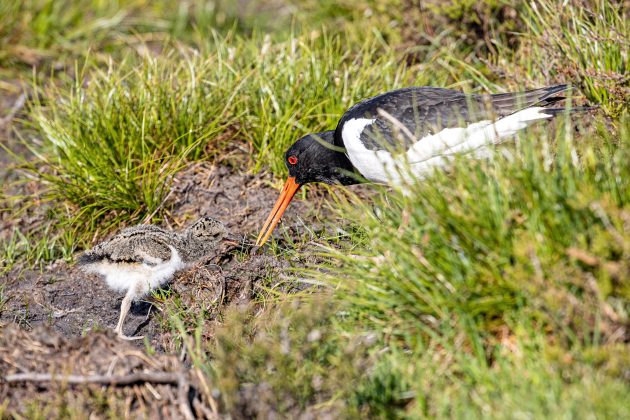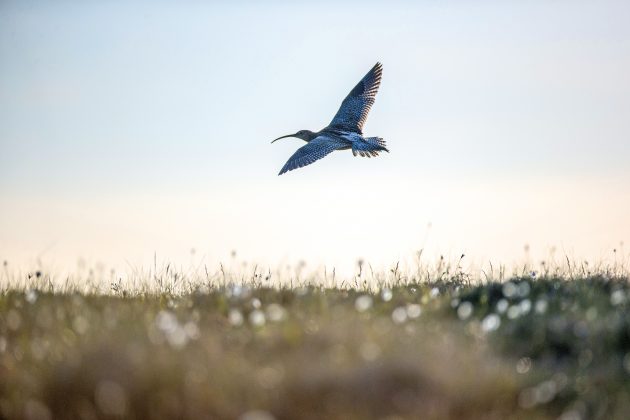At the fourth Moorland Summit, conservationists of all stripes gathered to seek common ground in order to protect our moors and the species that rely on them
Beneath a cloudless azure sky on the Lancashire moorland, not far from an abandoned stone barn, a diurnal short-eared or ‘bog’ owl is clapping its wings 50 feet above the ground. It is ‘listening’ for a vole, which is how it hunts: one ear unevenly placed above the other, circling and swooping until it is joined by a mobbing lapwing whose nest and young are hidden among the white grass and heather below. Welcome to nature’s avian daily flight for survival.

This 7,000-acre managed moor provides nature, sanctuary and a food supply for owl and lapwing alike. So, too, it does for curlew and oystercatchers and, as I was to find out over the next 24 hours as a guest of the fourth Moorland Summit, a myriad of other birdlife, insects and fauna. Organised by the well-known wildlife photographer and author Tarquin Millington-Drake, the 20 or so delegates and speakers were drawn from interested parties as varied and diverse as the moorland bird world itself.
“The main object of these summits is to educate those who have not witnessed the bird and human community a well-managed moor creates and, perhaps more importantly, to bring people who may never consider being in the same room together to do exactly that for the sake of Britain’s wildlife,” Millington-Drake told us. “My team of volunteers believes that the chief executives of today (of not just shooting but all conservation organisations), who represent members who all love birds and wildlife, are being irresponsible and letting the British wildlife-loving public down if they continue their feuds instead of talking to each other and seeking compromise and ways forward. While they argue, British wildlife collapses, so the talking and working together needs to start now, and that is what our guests are assembled to do.”
 This was to be no ordinary gathering. It involved an informal but high level of real-life speakers, who have lived and worked on the land, and two 4×4 ‘safaris’ of two hours each to observe all the flora and fauna of the moor and the birds with often day-old offspring. “There is so much to be learned by visiting a moor out of the shooting season,” Millington-Drake continued. While we could observe the empty stone butts that may be used during the season, here was an opportunity to view close up the avian community and ecosystem that goes to make up a grouse moor, often using those same butts for habitat and raising their young. “Shots who just turn up on the day are missing so much. A grouse moor is a living entity 365 days a year. It gives community and employment, and all this is done by private investment, contributing to protecting the largest area of upland moorland in Europe and all that thrives upon it,” Millington-Drake concluded.
This was to be no ordinary gathering. It involved an informal but high level of real-life speakers, who have lived and worked on the land, and two 4×4 ‘safaris’ of two hours each to observe all the flora and fauna of the moor and the birds with often day-old offspring. “There is so much to be learned by visiting a moor out of the shooting season,” Millington-Drake continued. While we could observe the empty stone butts that may be used during the season, here was an opportunity to view close up the avian community and ecosystem that goes to make up a grouse moor, often using those same butts for habitat and raising their young. “Shots who just turn up on the day are missing so much. A grouse moor is a living entity 365 days a year. It gives community and employment, and all this is done by private investment, contributing to protecting the largest area of upland moorland in Europe and all that thrives upon it,” Millington-Drake concluded.
Simon Lester, a former headkeeper at Holkham in Norfolk and the Langholm Project in Dumfriesshire, shared his hope that the Summit would “encourage others on to the path of educating people on the importance of understanding the uplands, and the communities that look after them and survive because of them, and help those involved in their maintenance and the local farming community feel more included and valued. These moors are like miniature rainforests.”
BATTLE FOR THE UPLANDS
It was only right that the introductory speaker should be Ian Coghill. His book Moorland Matters: The Battle for the Uplands against Authoritarian Conservation is the most reasoned, researched, statistical, scientific and well-argued defence of grouse moor management. As the enlightened former Labour MP Kate Hoey, now Baroness Hoey of Lylehill and Rathlin, writes in the introduction, ‘Ian’s book shows clearly what a disaster for conservation it would be if the zealots who wish to end grouse shooting got their way.’

“The only estate I have ever owned was a car,” said Coghill, who was brought up in the industrial West Midlands town of Smethwick, to begin his talk. “Grouse shooting faces many challenges today,” he continued – and one only has to look at proposed licensing in Scotland for this bell to ring true. “One of the best ways of combating prejudice and misinformation is by exposing people to the reality of the benefits of moorland management and the people whose lives are entwined with our precious uplands.”
Mary Colwell, a “self-confessed left-wing vegetarian with vegan tendencies”, in her elegiac 2018 nature walk over Ireland, England and Wales, Curlew Moon, admits, ‘Curlew are twice as likely to be found on managed grouse moors than outside of one.’ Given that the population and ‘herd’ of the European curlew has decreased by 80% since the 1980s, this is an admission and validation that should carry some weight.
The overarching theme of Coghill’s book is this, he said: “You cannot hope to keep conservation of habitats while ignoring the people who own and manage the moorlands, and the community that economy supports. Owners of grouse moors are like owners of football clubs. Their wealth provides habitats and community and, outside the 16-week window when shooting takes place, an immense amount of public access. Furthermore, let us be 100% clear… grouse moors do not make money; their owners continue to support the multitude of work to maintain the moor and all its inhabitants whether there is a shooting surplus or not.” That is why a conversation among conservationists is crucial for the future of these habitats.
MOORLAND ‘SAFARI’
With the two ‘safaris’, one taken in the afternoon, the other early the next morning, it was time to witness the variety of species garnered because of the moor and to observe close up the philopatric nature of their residence, the mating for life, the staying in one place. Both Lester and Stephen Colmer, highly respected gamekeepers, were on hand to imitate grouse, curlew, lapwings, oystercatchers and voles, thus making the species more visible to those of us with a less practised eye as they cocked their head at the sound. Here was what WB Yeats called ‘the sweet crystalline cry’ of the red-throated male grouse as he guarded his wife and chicks. Curlew with their young and lapwing chicks, described by Millington-Drake as resembling “bumblebees in nappies”, waddled within such proximity that field glasses were unnecessary.

“This is very close to paradise,” said Coghill as, from a high point on the moor, we could view stone-wall farming tofts below and, in the far distance, the sea shimmer of Morecambe Bay. “It is not a monoculture for grouse. It is the mosaic of a rare, important and varied ecosystem.” He highlighted several important truths: heather burning does not burn wet peat was one; that the moorland is under threat from people wanting to plant trees to monetise the landscape for carbon credits was another. “Only on grouse moors do you get such a concentration of ground-nesting birds. Without the grouse many would become quietly extinct.”
What then are the ingredients of the mosaic? It fell to Lester to list several of the components that flourish because of grouse moor management. The moor that we explored is managed by three full-time keepers who may each travel by quad bike up to 20 miles daily to legally check for such predators as foxes and rodents. The floral range includes cornberry, crowberry, cranberry, sundew, bilberry, sheep’s sorrel and carpets of milkwort and butterwort. And of the bird species, aside from grouse? Curlew, lapwings and oystercatchers, golden plover, snipe, stonechat, skylark, meadow pipit, cuckoos and sand martins. Between us we also saw hen harriers, buzzards, kites, kestrels, merlin, short-eared and little owls.
Sitting quietly in the vehicles, we allowed the birds to relax and go about their natural behaviour looking after the chicks. They did so in contrasting ways, from the laissez-faire of the lapwings to the intimate actual passing of food to oystercatcher chicks that would equally pretend to be rocks if ordered by their parents.
ARTISTS AND INFLUENCERS
The delegates at this informal Summit included not just gamekeepers and environmentalists but artists, photographers, students and influencers. This was evidenced by the range of those attending. Influencer Nicole Moore discovered fieldsports 13 years ago and hasn’t looked back. “My dream is to bring this world to the big screen in a way that educates and brings us all closer together – and closer to our food,” she said. Dog trainer and volunteer host Ricky Moloney told me, admiringly, “I have never before seen so many nesting birds.”

Robert Hall, keeper on the noted Norfolk Houghton estate, revealed, “I have come home inspired, motivated and more positive to carry the battle forward. I’ve never lacked motivation for game and wildlife management but have grown increasingly despondent about all of our futures from the external pressures that are being put on game and wildlife managers. However, having listened to and engaged with people at the event, it has challenged me to think again about the future and to try harder to engage and educate.” Another guest, Arthur Scott, a wild grey partridge enthusiast, said, “What Tarquin has done is gather people to express their varied views in a friendly and relaxed atmosphere and, furthermore, has got people to listen to each other.”
Alexandra Henton, Editor of The Field, who attended on another day of this year’s Moorland Summit was adamant that “we need to keep the cross-pollination of ideas and conversations going after we leave the proximity of the moor. There is so much good intent and good work happening that it is beholden upon the chief executives of all conservation organisations to keep lines of communication open and to understand one another. Misinterpretation is all too easy when the stakes are this high. Would a regular meeting of all the conservation CEOs, in one room (inspired by what we have witnessed at the Moorland Summit), help things to move forwards? Perhaps it might. We should definitely try.”
There are many paintings but no hymn to the grouse, perhaps only a lament at the ignorance of its protection and management and the myriad benefits it brings to other wildlife and communities, funded by private investment. Foremost is the European curlew. So let the curlew ‘whaup’ out in the grouse’s defence in the hands of two of our greatest 20th-century poets, Ted Hughes and Norman MacCaig. Hughes wrote that they ‘lanced their voices/ through the skin of this light’. For MacCaig, who summered each year in the Scottish Highlands away from his Edinburgh home, the curlew’s voice had:
‘Music as desolate, as beautiful
As your loved places,
Mountainy marshes and
glistening mudflats,
By the stealthy sea.’
It would be nothing but a disaster if the call of the grouse fell silent, taking the ‘whaup’ of the curlew with it.




